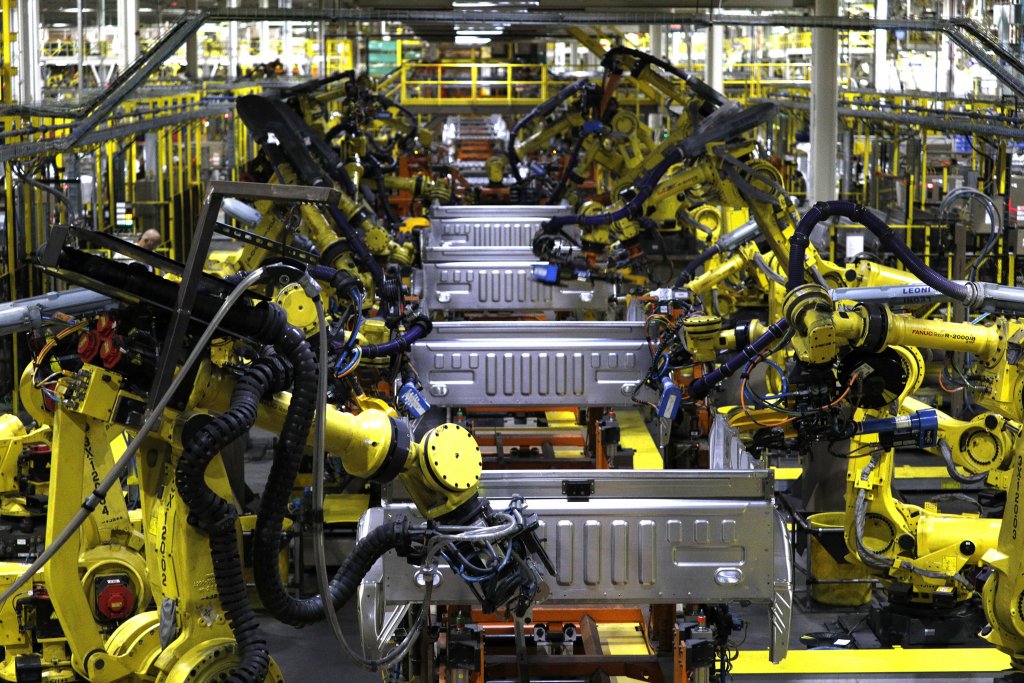Ford F150 trucks go through robots on the assembly line at the Ford Dearborn Truck Plant on September 27, 2018 in Dearborn, Michigan. The Ford Rouge Plant is celebrating 100 years as America’s longest continuously operating auto plant. | Bill Pugliano/Getty Images
Michigan’s economic recovery since the early days of the deadly Covid pandemic has been pretty, pretty, pretty good, as “Curb Your Enthusiasm” star Larry David might say.
The state’s jobless rate hit 22.4% in April 2020, one of the highest in the country, as COVID took hold. Michigan lost nearly 400,000 jobs that year as the economy shut down and tens of thousands of Michiganders died from the virus.
Since then, the state has recovered those jobs and added about 50,000 more. Michigan had the highest payroll job level and the lowest unemployment rate last year in more than two decades, according to a recent report by the Michigan Center for Data and Analytics, a state agency.
“Michigan’s workforce has made remarkable strides in the past several years,” said Shibani Putatuna, an economic specialist at the MCDA.
Fain rallies with Stellantis UAW members at Trenton plant ahead of strike authorization vote
And state residents are feeling pretty good about it. More than half of statewide voters (53.1%) in a September Detroit Regional Chamber poll said Michigan was on the right track, an 11 percentage-point jump from the chamber’s May survey and the highest level in four years.
Plus, fears about inflation, a major issue in this year’s election campaign, also are fading in the minds of Michigan voters. Just 15.6% of those polled said inflation is growing, down significantly from the 44.9% of those who said in November 2023 that inflation was getting worse.
But — and you knew this was coming — there’s a check engine light flashing on Michigan’s economic dashboard demanding attention in an economy that’s becoming more technical and service-oriented and requiring more higher-educated workers.
For all its recent economic progress, Michigan is, at best, just running in place against state competitors. In per-capita income, for example, Michigan ranked 39th last year in per capita income, the same as in 2022.
Michigan per capita income of $61,144 was $11,413 less than in Minnesota, and $11,101 less than in Illinois, the two wealthiest Great Lakes states. Both boast higher percentages of college graduates than Michigan.
Inflation-adjusted median household income in the state fell slightly last year to $69,183 from $69,750 in 2022.
In both income measures, Michigan ranked below the national average, a steep fall for a state that in the 1970s regularly exceeded national income averages.
Michigan’s per capita income was just 87.1% of U.S. per capita income in 2023. There have been only two other years since 1970 in which the state’s percentage of U.S. income has fallen that low: 2022, and 2009 at the depth of the Great Recession.
So why is that, considering that the state’s industry makeup is mostly comparable to that of the nation?
The culprit appears to be Michigan’s overreliance on factory jobs that have been in a long-term decline and—outside of auto assembly plants—no longer pay high wages. And there are only about half as many auto manufacturing jobs in the state as there were more 35 years ago.
While Michigan’s employment share in various industries mirrors that of the nation, the state is far more concentrated in manufacturing. Nearly 14% of the state’s workers are employed in manufacturing, compared to 8.3% of workers employed in manufacturing nationwide.
Wages in Michigan’s auto parts plants, where most of the state’s auto-related factory jobs are located, are essentially the same as they were 18 years ago.
Michigan has only about two-thirds the number of manufacturing jobs it held 25 years ago. That number could grow as automakers, computer chip manufacturers and others are building new factories in the state.
But the MCDA predicts the state will lose 18,250 manufacturing jobs by 2032. About half those job losses will be in the auto industry, a result of increased automation.
Most of the state’s projected job growth will be in health care; education; company management; and professional, technical and scientific services. While there will be a mix of high- and low-wage jobs in those categories, especially health care, most of the good-paying jobs will require at least a four-year degree.
That’s true in the auto industry, as well. While it’s important to maintain auto manufacturing jobs, growing the engineering and other knowledge jobs the industry requires is even more essential as software becomes the core vehicle building block.
Take General Motors, for example. It once had factories all over the country. But as of the end of 2023 the automaker employed more salaried workers (53,000) in the United States than it did hourly workers (46,000), according to its latest annual report.
Yes, Michigan needs to provide better jobs for those without college degrees because about two-thirds of residents don’t possess them. Forty-one percent of state’s workers earn less than $20 an hour, according to the MCDA report.
But — and I feel like I’ve said this a million times — Michigan needs to boost the percentage of residents with a four-year degree or above to provide the talent employers increasingly need and to become more prosperous.
Recreating the manufacturing economy of 50-plus years ago, as seemingly every political candidate in each election cycle promises, won’t get us there.
GET THE MORNING HEADLINES.

